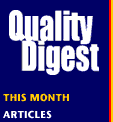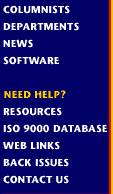|
|
|
|
Today's Specials |
|
|
|
|
Measurements, Telecommunications
Quality and TL 9000
______________
by Art Morrical
In the absence of measurements, customers fear the worst about the performance of a product. After all, without measurements, a customer is buying blindly. Thus, taking measurements of the product and making them available to your organization's customers is a good way of marketing the quality of your product.
In theory, it's possible to create any number of measurements. Of greater importance is that the information extracted from the data be useful and accurate. When an organization undertakes the data collection, there's a tendency to over-collect and under-analyze. The quantity of data collected and the number of measurements taken doesn't need to be overwhelming. It's important to understand that measurements, in and of themselves, are not the goal of a useful quality management system; analysis of the measurements is. Analysis is the key to transforming raw data into useful pieces of information. Keeping this in mind, it's essential that a measurement program be analysis-driven rather than data-driven.
The QuEST Forum Measurements working group developed some of the TL 9000 measurements using the experience of the group's members with GR-929-CORE RQMS (Core Reliability and Quality Measurements for Telecommunications Systems), telecommunications industry measurements that have been in use for (and have been evolving during) the last decade. Due to the RQMS linkage, when a measurement from RQMS is used by a supplier registered to TL 9000, the supplier can use the RQMS measurement to conform with TL 9000 and can send those measurements to the University of Texas at Dallas for the TL 9000 Measurements Repository System without alteration.
The calculations themselves must be in compliance with the latest issue of the RQMS. The intent is to prevent redundant effort by suppliers when both RQMS and TL 9000 measurements are contractually required. In that situation, TL 9000 conformance audits would accept an RQMS-based procedure.
For example, at the time of TL 9000 implementation at Lucent Technologies' 5ESS Project, the project was producing the RQMS measurements needed for TL 9000 conformance and registration and had been sending them to its subscribing customers. TL 9000 also requires that objectives be placed on the measurements and that the results be sent to the supplier's management. Since the RQMS measurements have customer-defined objectives that the 5ESS Project was already embracing, the project was in conformance with the required measurements for TL 9000. The 5ESS Project produces and sends quarterly reports of the measurements to its customers that detail current trends and provide data analysis.
An organization can gain many benefits by entering data into a data repository system:
![]() The use of drop-down menus provides the user with data accuracy.
The use of drop-down menus provides the user with data accuracy.
![]() Data verification--using data checks and selecting from standard field values--at
the time the measurements are collected avoids typing and abbreviation errors.
Data verification--using data checks and selecting from standard field values--at
the time the measurements are collected avoids typing and abbreviation errors.
![]() Periodic database audits can clean up inaccuracies in the data.
Periodic database audits can clean up inaccuracies in the data.
![]() Long-term measurement trends reveal a measurement's variability and assess a supplier's maturity and room for improvement.
Long-term measurement trends reveal a measurement's variability and assess a supplier's maturity and room for improvement.
![]() The data identifies the areas where management can initiate action to get the biggest payback.
The data identifies the areas where management can initiate action to get the biggest payback.
In addition, the TL 9000 measurements will provide industry means and ranges. This allows a telecommunications supplier to perform a self-evaluation and fine-tune its resource allocation in response to its position relative to the industry direction.
Another key to an effective measurements program is keeping the measurements visible. The measurement results need to be visible to all project members, which the 5ESS Project has been accomplishing by using Web-based access to TL 9000 customer measurement data, called a "dashboard." Dashboard measurements are tools to help employees monitor the progress of the organization's business.
Just as a driver glances at the gages on the dashboard to monitor speed, temperature or oil pressure, project members can look at their "dashboards" and, based on the status of the business, take appropriate actions to maximize performance. The "gauges" are updated monthly to give everyone the most timely and accurate figures available. Management can set objectives based on the figures and manage the measurements to close any performance gaps. Using the TL 9000 measurements, management can focus quality improvements on customers' definitions of quality and how they can be demonstrated through measurements.
Measurement results can be used in executive reviews because they provide a window into customer interactions, thus connecting a customer sales team to a product team's performance. Customer visits can then cover shared measurements results and conclude with a joint setting of gap reduction goals. The most important measurement area for improvement can also be jointly determined.
Measurements are a key part of a healthy and effective management system. Overall product quality improvement is the result of increased visibility of measurements data that show the level of compliance with product specifications and the integration of these measurements into standard management practices. Product quality improvement also results from increased focus on areas needing attention.
When TL 9000 measurements are used, there can be enhanced customer/supplier relationships and the introduction of improvement programs based on well-defined measurements. Better-informed decisions can be made about where to apply resources. The TL 9000 measurements also lead to standardized data collection that provides opportunities for industry comparisons and benchmarking. The long-term use of the TL 9000 measurements can result in improved industry performance and improved telecom services.
About the author
Art Morrical is a manager of the Lucent Technologies 5ESS Project and an initial participant in the QuEST Forum, working with the Metrics, Metrics Implementation, Requirements and Training work groups.
Menu Level Above
This Menu LeveL
Menu Level Below
Copyright 1999 QCI International. All rights reserved.
Quality Digest can be reached by phone at (530) 893-4095. E-mail: Click Here


